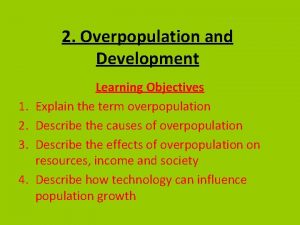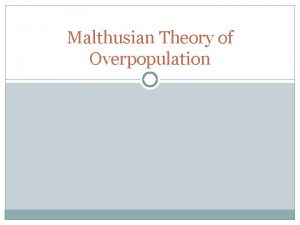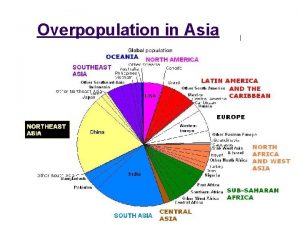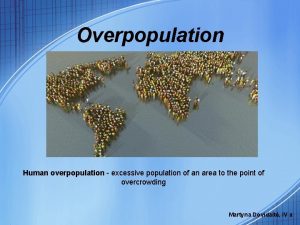Thomas Malthus on Overpopulation Malthus was an English






















- Slides: 22

Thomas Malthus on Overpopulation -Malthus was an English economist who lived from 1766— 1834 -he was the first to argue that population growth was far outnumbering the development of food supplies “An Essay on the Principle of Population” (1798) -in this, his most famous work, Malthus theorized that while population increases geometrically (1, 2, 4, 8, 16, 32, 64, 128…) food supply increases arithmetically (1, 2, 3, 4, 5, 6, 7, 8, 9, 10)

Today 1 person 1 unit of food 25 years 2 persons 2 units 50 years 4 persons 3 units 75 years 8 persons 4 units 100 years 16 persons 5 units 125 years 32 persons 6 units 150 years 64 persons 7 units Malthus said “moral restraint” was needed to reduce CBR or disease, war, famine, or other disasters increased CDR

Neo-Malthusians: Some geographers are reexamining Malthus’s theory because of Earth’s high NIR during late 1900 s Two Reasons to Reconsider Malthus’s Theory: 1. The gap between population growth and resources is wider than even Malthus anticipated 2. -he failed to anticipate that the greatest population growth would occur in the poorest countries because the transfer of medical technology but not wealth will affect the LDCs differently--it will extend time spent in Stage II (high growth) 3. -in East African countries, population growth has outpaced economic growth 4. -income is rising 2% each year, but population increasing 3% annually 5. The result is that most people in these countries are economically worse off than they were 10, 20, or 30 years ago 2. World population growth is stripping Earth of many resources 3. -can see this through growing number of wars and civil violence 4. -people need to start fighting for resources 5. Some human populations have already exceeded the carrying capacity of

Malthus’s Critics: Malthus’s theory is based on a fixed supply of world resources -critics feel that humans have some ability to choose courses that can expand food supply and other resources -new technology can offset scarcity of minerals and arable land by using existing resources more efficiently and substituting new resources for scarce ones Esther Boserup and Simon Kuznets—feel higher human population may stimulate economic growth and therefore produce more food -can the Earth produce more food than it does now? Julian Simon—says that more people means more brains to invent new ideas which will improve life Marxist Friedrich Engels argued that the Earth has sufficient resources to eliminate global hunger and poverty -believes that capitalism causes hunger and poverty because workers do not have enough food because they do not control the production and distribution of food and they are not paid sufficient wages

Many argue that a larger population creates more consumers that can create greater demand for goods which can result in more jobs Many African political leaders feel that increased population means more power as more young people are able to serve in the armed forces Malthus Theory and Reality Vaclav Smil—geographer who has found that food production has consistently grown at a faster rate than the natural increase rate since 1950 Reasons Why Food Production Has Grown Faster Than Malthus Theorized: 1. Better growing techniques 2. Higher yielding seeds 3. Cultivation of more land 4. Many people around the world cannot afford food or they do not have access to food sources, but these are in reality problems of wealth distribution rather than insufficient global production of food

Population has not grown as fast as Malthus predicted -he expected population to hit 10 billion by 2000, but it has reached only 6 billion -he did not see cultural, economic, or technological advancements that helped more countries enter Stages III and IV of the demographic transition During the 1990 s, the world NIR dropped from 1. 8% to 1. 3% -from 2. 1 to 1. 6% in LDCs -from. 5 to. 1% in MDCs Despite a lower NIR during the 1990 s, the population base was broader, so overall population continues to rise

Reasons for Declining Birth Rates: Two Ways NIR can Decline: 1. Lower CBR 2. 2. Lower CDR 3. Lower NIR has been a result of lower CBR, but in some sub. Saharan African countries higher CDRs have lowered NIR (AIDS) 4. Two Ways Used to Help Reduce Birth Rates: 5. Economic Development 6. 2. Distribution of Contraceptives 7. Varied economic and cultural conditions cause variations among countries

Economic Development: A wealthier community has more money to spend on education and health-care programs that would promote lower birth rates -get more women to attend school and remain in school later -more likely to learn employment skills -gain more economic control over their lives Help to make more informed choices about reproduction Improved health-care programs will improve infant mortality rates -improved pre-natal care -education about sexually transmitted diseases -child immunization More children surviving will likely cause women to have fewer overall children

Angola is a country in sub-Saharan Africa which is typical of LDCs and is an area of concern for high population growth Angola’s population pyramid shows typical Stage II high growth Longer life expectancy shows that although birth rates remain high, people are living longer (likely due to introduction of new medicines)

Angola Total Fertility Rate TFR seems to be leveling Demographers project that Angola will move into Stage III (Moderate Growth) as TFR begins to lower People will continue to live longer More babies will survive Less babies will be born

Distribution of Contraceptives—can cause a rapid decline in CBR -in LDCs, demand for contraceptive devices is greater than supply Bangladesh: -in 2000, about 50% of women used contraceptives -in 1975, only 6% of women used contraceptives In areas of Africa and SW Asia, the percentage of women using contraceptives is still very low Women here receive less education and have fewer political rights Women here regard having a large number of children as a measure of higher status Men here also regard having many children as a sign of their own virility Many religions also oppose some or all birth control devices -Roman Catholics -fundamentalist Protestants -Muslims -Hindus Government regulations (such as in China’s one-child policy) have also rapidly lowered NIR rates Analysts agree using both methods would be the best way to lower CBR

World Health Threats: Areas of sub-Saharan Africa have had declining NIR despite higher CBR because of higher CDR (caused by AIDS) Epidemiologic transition: focuses on distinctive causes of death in each stage of the demographic transition epidemiology—branch of medical science concerned with the incidence, distribution, and control of diseases that affect large numbers of people EPIDEMIOLOGIC TRANSITION Stage I—Pestilence and Famine -principal causes of human death in this stage is infectious and parasitic diseases, accidents, attacks by other animals and other humans Black Death (Bubonic Plague)—history’s most violent Stage I epidemic -about 25 million Europeans died between 1347 and 1350 (about half of the continent’s entire population)

The Black Death had a large effect on human population and can be seen in large scale population growth charts

EPIDEMIOLOGIC TRANSITION Stage II—Receding Pandemics Pandemic: disease that occurs over a wide geographic area and affects a very high proportion of the population -improved sanitation, nutrition, and medicine during the Industrial Revolution reduced the spread of infectious diseases Cholera: killed 500, 000 in New York City in 1832 -killed 20% of the population of Cairo, Egypt in 1931 Dr. John Snow—(1813— 1858) Used geographic methods to show the spread of cholera He mapped the deaths from cholera in 1854 in the poor London neighborhood of Soho Many felt the victims were being punished for sinful behavior -being poor at this time was also considered a sin Snow overlaid a map of the distribution of cholera victims with a map showing the distribution of water well pumps -these wells were being used by the poorer people for drinking, cleaning, and cooking

Snow’s findings showed a large percentage of victims were clustered near one particular pump Water tests from this pump proved the water was contaminated Water pumps were reconstructed to avoid contamination

EPIDEMIOLOGIC TRANSITION Stage III—Degenerative and human-created diseases Characterized by less deaths from infectious diseases and an increase in chronic disorders associated with aging -includes cardiovascular diseases (heart) and cancers Many countries are experiencing less deaths from infectious diseases -leprosy in Africa—from 483, 000 (1990) to 159, 000 (1993) -worldwide polio—from 39, 000 (1985) to 6000 (1994)

EPIDEMIOLOGIC TRANSITION Stage IV—Delayed Degenerative Diseases Cancers and heart disease spread more slowly as people age Medical operations (i. e. —heart bypass) and improved health behavior (i. e. —reduced tobacco use) help to delay degenerative diseases Possible Stage V—Reemergence of Infectious and Parasitic Diseases -would result in higher CDR, which could cause irreversible population decline due to lower CBR and TFR and areas already in zero population growth Three Explanations for Possible Stage V: 1. Evolution—infectious disease microbes have evolved and developed resistance to drugs and insecticides Malaria: DDT helped reduce malaria from 1 million deaths in 1955 to 18 total deaths in 1963 in Sri Lanka -now, 2 million deaths in Sri Lanka each year from DDT resistant mosquitoes that carry malaria

2. Poverty Tuberculosis (TB)—almost eradicated in MDCs but remains a major cause of death in LDCs -TB treatment is an economic strain in many LDCs

3. Improved Travel 4. -people travel and carry diseases whith them while also being exposed to others’ diseases 5. SARS (severe acute respiratory syndrom)—originated in China in November of 2002 6. -SARS diffused around the world in just days 7. -information about SARS was also able to distribute rapidly 8. -those exposed were quickly quarantined

Terrorism Some fear that terrorists may be responsible for spreading infectious diseases The last smallpox outbreak was in U. S. in 1947 -began with 20 cases in Oklahoma -within three months, over 1 million died in 25 states The last smallpox case in U. S. was reported in 1947 -most Americans were inoculated The last smallpox case in the world was reported in 1977 Somalia Since the disease has been eradicated, most people have quit receiving immunization -makes them susceptible

AIDS—(acquired immunodeficiency syndrome) Most lethal epidemic in recent years HIV (human immunodeficiency virus) causes AIDS -200, 000 HIV cases in 1980 -rose to 8 million by 1990 -40 million in 2001 Since 1995, 95% of those with HIV and 99% of new HIV cases have occurred in LDCs Sub-Saharan Africa: -has 11% of world’s population, but 70% of the HIV population -40% of adults in Botswana have HIV -5 million in South Africa have HIV CDR rose sharply in sub-Saharan Africa during 1990 s because of AIDS -Botswana life expectancy from 55 (1980) to 39 (2000) -Botswana and South Africa both likely to lose population through 2050 Epidemic diseases such as AIDS will lower world population growth projections

 Overpopulation theory
Overpopulation theory Thomas malthus industrial revolution
Thomas malthus industrial revolution Malthusian theory
Malthusian theory David ricardo and thomas malthus
David ricardo and thomas malthus What is the current intraregional migration trend in the us
What is the current intraregional migration trend in the us Thomas robert malthus (1766-1834)
Thomas robert malthus (1766-1834) Thomas robert malthus
Thomas robert malthus Thomas malthus carrying capacity
Thomas malthus carrying capacity Overpopulation definition
Overpopulation definition Thesis statement examples for problem solution essay
Thesis statement examples for problem solution essay What is population explosion
What is population explosion Malthus
Malthus Malthus rant
Malthus rant Biografia de robert malthus
Biografia de robert malthus Forensic pathologist vs forensic anthropologist
Forensic pathologist vs forensic anthropologist Speak theme
Speak theme Spoken english and broken english summary
Spoken english and broken english summary Semantic change
Semantic change Father of tragedy
Father of tragedy Old english vs modern english
Old english vs modern english American vs english words
American vs english words Differences between americans and british
Differences between americans and british Old english vs modern english
Old english vs modern english






































